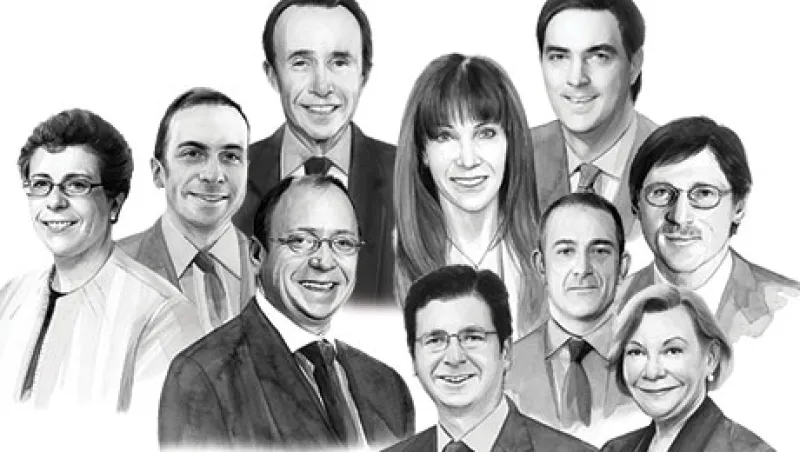All-America
Research TeamAnalysts With Most No. 1 AppearancesFirms at No. 1To mark the 50th anniversary of Institutional Investor magazine, the top analysts of II's flagship, All-America Research Team ranking looked back on their industry and shared what they see for the future. Though demand for sell-side research remains as high as ever, they're stepping up their game to keep their competitive edge amid challenges tied to technology and regulation.
"In some ways, the world never changes," says Edward Hyman, chairman of Evercore ISI and head of its economic research team, while sitting in the firm's office in New York. Even as technology advances, and analysts have faster ways of producing and disseminating their research, the job of the sell-side analyst has remained almost the same, he says.
There's another way the times haven't changed: Hyman's position as the No. 1 economics analyst in II's All-America Research Team ranking since its inception in 1972, with a record 36 first-place appearances on the list. Over the course of his career, Hyman says the demand from the buy side hasn't changed, and almost no firms have the inclination to do research in-house."
Whether it's J.P. Morgan or Point72 or BlackRock, they are all geared for their people to consume Wall Street research," Hyman says.
Still, almost all the analysts agree that enough change is happening underfoot to keep the sell side on its toes. One change is the second phase of the Markets in Financial Instruments Directive, or MiFID II, which will take effect January 2018 in European markets and will require research firms to "unbundle," or fully disclose, the costs of its research, which previously were often wrapped inside trading commissions or other charges.
As that unbundling takes place on a global basis, clients are spending more time reviewing how they pay the Street, says Jonathan Rosenzweig, head of Americas equity research at Citigroup, which ranks second in II's Hall of Fame of firms with the highest number of No.1 analysts. As those pressures grow, Citi is "stepping up instead of stepping back," Rosenzweig says, noting that the firm has filled 14 senior analyst positions in the U.S. alone over the past two years and currently has no open seats on the team.
Differentiated analysis will continue to be in higher demand over maintenance research as unbundling continues, says Eric Miller, head of global markets client and content for Credit Suisse, the No. 3 firm in II's top rankings. "Unique content, sometimes with a contrarian view, and a true bottom-up approach [are important]," he explains. Credit Suisse is also being more aggressive in trying to reach clients, hosting more conferences each year to bring together clients and speakers. In February the firm hosted the 22nd Annual Energy Summit in Vail, Colorado, and will host a technology, media, and telecom conference in Arizona in November.
Candace Browning, head of global research at Bank of America Merrill Lynch, the top firm in the history of II's All-America Research Team survey, agrees with Hyman's view that not much has changed insofar as analysts are still answering "the same old questions" — that is, not telling clients whether to buy a stock, but probing markets to provide insight they may never have considered. Browning has had a long career as an analyst, having earned a ranking in II's survey for 17 years as an airline analyst before moving into research management.
"We're using lots of new technologies, whether it's examining what people are saying on social media, whether it's scraping websites, whether it's our own surveys," she says. "Using big data capabilities over the next ten years is going to change the research franchise."
Aside from producing quality, unique research, it turns out that, like in many areas of life, a sense of humor can take an analyst far.
"Great analysts make their clients laugh, make them think, and make them money," Rosenzweig says, adding that good analysts may be able to do only two of the three well.
One such analyst is George Staphos, managing director and analyst in the packaging and paper and forest products sectors at Bank of America Merrill Lynch. He's recently had one of the larger jumps among II's all-time top-ranked analysts, rising to 10th place last year from 13th in 2011. Staphos is also no stranger to the top ranking, with a total of 17 No. 1 appearances on II's All-America Research Team rankings over the years. His success may be based in part on the humor he injects into his research reports, cutting through the weeds in a not-so-sexy industry: "We're not landing people on the moon [in the packaging sector]," Staphos notes.
Staphos also tries to be a "student of history," saying that taking an immediate to long-term view of the market has been his consistent strategy over the years. He's noticed companies becoming less communicative and more guarded over the years, a situation that's forced him to adapt to stay competitive. Staphos says he's developed a network of non-company contacts to help form a mosaic of the firms and sectors he's covering.
Adapting is a Bank of America Merrill Lynch strength. The firm uses data to track which analyst reports are most read, adjusting its content as needed, according to Browning. In late 2015 the firm began distributing research through HTML links instead of PDFs, capturing data on what reports are popular. Every Friday, Browning receives a report with the most and least-read research of the week. "You don't want to be on the least-read research," Browning says, laughing. Some of the firm's most popular reports have been primers, or deep dives into an industry or product, which shows the buy side still values educational pieces, she says.
Even more than MiFID II, Hyman maintains that the challenge all analysts will continue to face is the task of cutting through the vast amounts of information that hit their clients' desks daily. A typical high-profile player on the buy side may get 800 emails a day, he says, adding that there's a "breaking point" where people must keep a tight handle on the amount of information they consume.
"Something has to give," Hyman says. "I don't know what's going to give, but some way or other, people are going to have to get control of their email.
"Technology has also "shortened the shelf life of news flow," according to Nicholas Rosato, head of North America equity research for J.P. Morgan, the No. 4 firm in II's ranking. That makes it more difficult for analysts to keep pace with changes reported in markets as they compete for clients' attention.
Thematic reports are one of the areas where analysts and firms can set themselves apart in their research. "[Clients] don't want something they can get from investor relations and reading the annual report," Browning says. For example, Bank of America Merrill Lynch's "stamped" reports, such as one that estimates the effects of the first 200 days of President Donald Trump's administration on various sectors, can have almost 40 times the average readership.
Gender diversity —a theme that captured attention this year with the installation of the Fearless Girl statue, a young girl standing defiantly with her hands on her hips as she faces down Wall Street's iconic charging bull — is another area where analysts have gained traction with clients. Credit Suisse last year published its second edition of a report on gender diversity on boards and in senior management, reconfirming the link between increasing the number of women in leadership roles and improved business performance. Thematic and cross-sector research such as this has performed well with clients, according to Credit Suisse's Miller.
It all adds up to a critical part of a research analyst's job — staying on top of the clients' reading lists as their email inboxes are inundated with information.
"If you're an analyst at a buy-side firm, you'll probably keep up with five analysts," Hyman says. "If I was doing it, I'd keep up with maybe three."
As an economist would, Hyman invokes the law of diminishing returns, noting that though the buy side will consider the research and views of several analysts, at some point there will be too much noise to be able to come to a decision about an investment. That's the kicker facing research analysts. "If you're not in the top five, it's going to be very tough," Hyman says.
What does II's top economist see for the future? "I travel a lot, and every place I go is booming. Booming," Hyman emphasizes. Des Moines, Iowa; Prescott, Arizona; Fort Wayne, Indiana; Sioux Falls, South Dakota — he rattles off a list of cities where he's seen construction on the rise.
Walking through the Evercore ISI office, Hyman stops at a desk to unfold the day's New York Times, pointing to the headline "What Decline? A Rural Hub Thrives in Idaho."
All of this adds up to an environment ripe for investment. As world economies improve and balance sheets strengthen, buying stock is still the best way to invest, Hyman says. Which means, even with MiFID II and continuously evolving technology, maybe the job of the sell-side analyst is safe after all.






